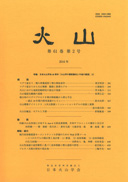
- Issue 4 Pages 105-
- Issue 3 Pages 69-
- Issue 2 Pages 21-
- Issue 1 Pages 1-
- |<
- <
- 1
- >
- >|
-
Makoto KOBAYASHI, Kaori AOKI, Masanori MURATA, Fumikatsu NISHIZAWA, Ta ...2020 Volume 65 Issue 2 Pages 21-40
Published: June 30, 2020
Released on J-STAGE: July 06, 2020
JOURNAL FREE ACCESSThis study established tephrostratigraphy and clarified the eruption history of Niijima volcano (Izu Islands, Japan) after the Miyatsukayama event (12.8-8.5calka) through geological survey around the central and northern parts of Niijima island, and Shikinejima and Jinaijima islands. Detailed explanation is summarized below. The Miyatsukayama eruptive event started at the north of Akazakinomine lava dome (central part of Niijima island) at 12.8calka. The series of eruptions formed Miyatsukayama lava dome, and produced Nj-MtG tephra (12.8-8.5calka) and K tephra (ca. 8.5calka). In particular, the first pyroclastic density current covered the Akazakinomine lava dome thickly, accompanying fallout deposits (Nj-Mt tephra) which were widely distributed in the northern part of Izu Islands. Subsequently, the Shikinejima event ejecting Nj-Sk tephra occurred at ca. 8calka. At ca. 7.5calka, H(s) tephra was produced by the eruption near Shikinejima island, and H(n) tephra was produced by the Niijimayama event. During the Miyatsukayama-nanbu event (ca. 5.5calka) producing Nj-Mt(s) tephra, pyroclastic density currents erupted from the southern part of Miyatsukayama lava dome, buried depressions on the Miyatsukayakma lava dome and formed horizontal and flat surface. The erupted pyroclastic material covered the Akazakinomine lava dome widely and formed pyroclastic cones and lava domes near the source. After that, the Wakago event (Ni-Wg tephra), the D tephra event and the Kudamaki-Atchiyama event (Nj-KdAt) erupted basaltic magma at ca. 3.6calka, ca. 1.6calka and AD 856-857, respectively. Several decades after the Kudamaki-Atchiyama event, the Mukaiyama event (Nj-My) occurred at the southern part of Niijima island in AD 886-887. The Mukaiyama event is the largest eruption during the last 12.8 kys. At Niijima Volcano, eruptions with the magnitude equivalent to the Mukaiyama event (>0.1DREkm3) have occurred every thousand years since the Miyatsukayama event, and the large area of the island was covered with pyroclastic density currents at each eruption.
View full abstractDownload PDF (8108K) -
Kohei TATEYAMA, Shino NARUKE, Hisashi SASAKI, Takuya FUKUI, Hiroyuki Y ...2020 Volume 65 Issue 2 Pages 41-51
Published: June 30, 2020
Released on J-STAGE: July 06, 2020
JOURNAL FREE ACCESSIn recent years, casualties caused by the impact of ballistic ejecta from sudden phreatic eruptions have drawn much attention, as observed with Mt. Ontake in September 2014 and Mt. Moto-shirane in January 2018. Hence, improvement of evacuation facilities (shelters) that protects against ballistic ejecta is expected as a forthcoming volcanic disaster prevention initiative. In many cases, the utilized evacuation facilities are outfitted by strengthening existing facilities such as mountain huts. Therefore, it is necessary to understand the baseline impact resistance against ballistic ejecta of the existing mountain huts. In the case of Japanese wooden buildings, Japanese-style rooms with tatami (Japanese-style thick straw mats) are often used. In this study, we focused on the impact resistance of tatami used for flooring. We conducted tests which simulated the impact of ballistic ejecta on various types of tatami, in order to assess the penetration limit of tatami. Three types of bodies of tatami (tatamidoko) were prepared: straw tatamidoko, non-straw tatamidoko type III, and straw sandwich tatamidoko. The projectile was simulated ballistic ejecta with a diameter of 128mm and a mass of 2.66kg, made using a vitrified grinding wheel. This object was launched at a speed of 22 to 69m/s using a pneumatic impact test apparatus. From the impact test, non-straw tatamidoko type III did not prevent penetration, even at an impact energy of 0.63kJ. Therefore, if non-straw tatamidoko type III was to be used in a mountain hut, it cannot be expected to protect against ballistic ejecta. On the other hand, the minimum energy of penetration of straw tatamidoko and straw sandwich tatamidoko were 4.9 and 4.1kJ, respectively, and they had sufficient impact-resistance against ballistic ejecta compared to the mountain hut roof. Thus, it was shown that the downstairs of straw tatamidoko and straw sandwich tatamidoko can be designated as “a safer place in the building”.
View full abstractDownload PDF (9650K)
-
Manami SUZUKI, Noriko TESHIMA, Kazuya YAMAKAWA, Takuma IKEGAYA, Kurumi ...2020 Volume 65 Issue 2 Pages 53-58
Published: June 30, 2020
Released on J-STAGE: July 06, 2020
JOURNAL FREE ACCESSDownload PDF (4496K) -
Nobuo GESHI, Yasuo MIYABUCHI, Satoshi GOTO, Linus Anye NCHE2020 Volume 65 Issue 2 Pages 59-66
Published: June 30, 2020
Released on J-STAGE: July 06, 2020
JOURNAL FREE ACCESSDownload PDF (5376K)
- |<
- <
- 1
- >
- >|